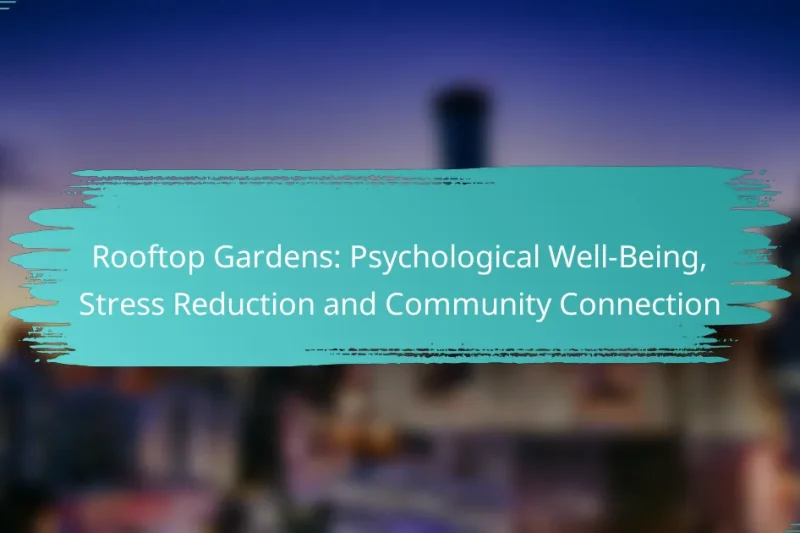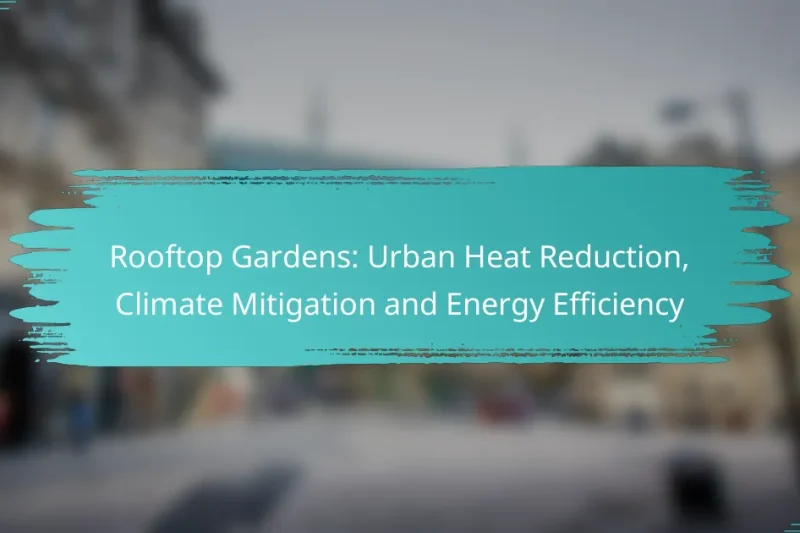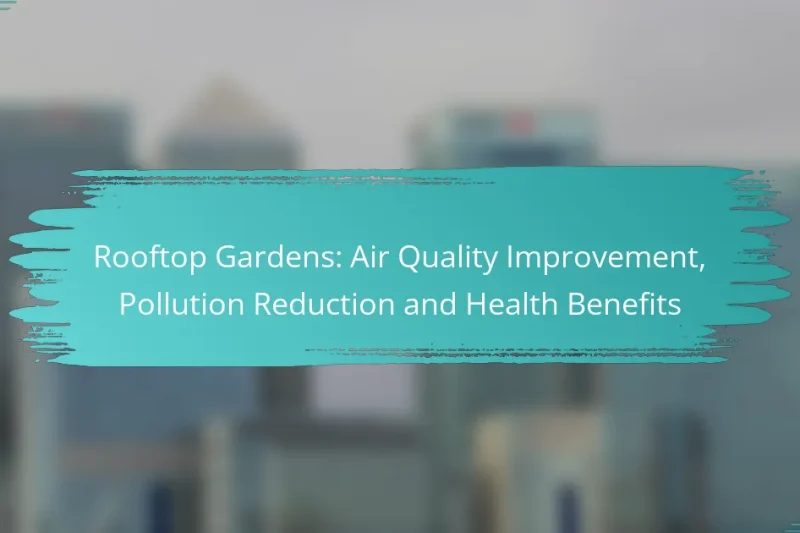Rooftop gardens are vital for enhancing biodiversity in urban settings by creating green spaces that support … Rooftop Gardens: Biodiversity Enhancement, Habitat Creation and Ecosystem SupportRead more
Benefits of Rooftop Gardens
Rooftop gardens are a valuable addition to urban landscapes, providing a range of benefits such as improved air quality, enhanced biodiversity, and increased property value. These green spaces not only contribute to sustainability by managing stormwater and reducing energy consumption, but they also promote health and well-being by offering a serene environment and access to fresh produce.
Rooftop Gardens: Energy Savings, Cost Efficiency and Sustainable Living
Rooftop gardens are an innovative solution for urban areas, offering energy savings through improved insulation and … Rooftop Gardens: Energy Savings, Cost Efficiency and Sustainable LivingRead more
Rooftop Gardens: Psychological Well-Being, Stress Reduction and Community Connection
Rooftop gardens serve as vital green spaces that significantly enhance psychological well-being by promoting relaxation and … Rooftop Gardens: Psychological Well-Being, Stress Reduction and Community ConnectionRead more
Rooftop Gardens: Urban Heat Reduction, Climate Mitigation and Energy Efficiency
Rooftop gardens serve as a vital solution for urban heat reduction, offering natural insulation and cooling … Rooftop Gardens: Urban Heat Reduction, Climate Mitigation and Energy EfficiencyRead more
Rooftop Gardens: Air Quality Improvement, Pollution Reduction and Health Benefits
Rooftop gardens serve as vital green spaces in urban environments, significantly improving air quality by filtering … Rooftop Gardens: Air Quality Improvement, Pollution Reduction and Health BenefitsRead more
What are the benefits of rooftop gardens in urban areas?
Rooftop gardens offer numerous benefits in urban settings, including improved air quality, enhanced biodiversity, and increased property value. These green spaces help mitigate the effects of urbanization while providing aesthetic and functional advantages to city dwellers.
Improved air quality
Rooftop gardens contribute to better air quality by filtering pollutants and absorbing carbon dioxide. Plants naturally take in harmful gases and release oxygen, which can significantly reduce the concentration of air contaminants in densely populated areas.
Incorporating a variety of plants can maximize air purification. For instance, using native species can be particularly effective, as they are well-adapted to local conditions and require less maintenance.
Enhanced biodiversity
Rooftop gardens create habitats for various species, promoting biodiversity in urban environments. By providing food and shelter, these gardens attract birds, insects, and other wildlife, which are often scarce in cities.
Designing gardens with diverse plant species can help support pollinators like bees and butterflies. This not only enriches the local ecosystem but also contributes to the overall health of urban flora and fauna.
Reduction of urban heat island effect
Rooftop gardens help combat the urban heat island effect by cooling buildings and surrounding areas. Vegetation absorbs sunlight and provides shade, which can lower rooftop temperatures significantly compared to traditional surfaces.
Implementing green roofs can reduce energy costs by decreasing the need for air conditioning in the summer months. This is particularly beneficial in cities where energy efficiency is a growing concern.
Increased property value
Properties with rooftop gardens often see an increase in value due to their aesthetic appeal and functional benefits. Buyers are increasingly interested in sustainable features that enhance living quality, making green roofs an attractive selling point.
In urban areas, the presence of a rooftop garden can lead to higher rental prices and property appreciation, making it a worthwhile investment for homeowners and developers alike.
Food production opportunities
Rooftop gardens can serve as productive spaces for growing fruits, vegetables, and herbs, promoting local food production. This not only provides fresh produce but also reduces the carbon footprint associated with transporting food.
Urban dwellers can cultivate small-scale gardens to supplement their diets, making it a practical option for those with limited access to green spaces. Community gardening initiatives can further enhance food security and foster social connections among residents.
How do rooftop gardens contribute to sustainability?
Rooftop gardens enhance sustainability by improving urban ecosystems and reducing environmental impact. They provide natural solutions for managing stormwater, increasing energy efficiency, and lowering carbon footprints.
Stormwater management
Rooftop gardens play a crucial role in stormwater management by absorbing rainwater and reducing runoff. This helps to mitigate flooding and decreases the burden on urban drainage systems, which can be overwhelmed during heavy rain.
By retaining water, these gardens can lower the risk of water pollution in nearby rivers and lakes. A well-designed rooftop garden can capture a significant portion of rainfall, often retaining around 50-90% of stormwater, depending on the plant selection and soil depth.
Energy efficiency
Rooftop gardens contribute to energy efficiency by providing insulation for buildings. They can lower indoor temperatures during hot months, reducing the need for air conditioning and lowering energy bills.
Studies suggest that buildings with green roofs can experience energy savings of 20-30% in cooling costs. Additionally, they can extend the lifespan of roofing materials by protecting them from UV rays and extreme temperature fluctuations.
Carbon footprint reduction
Rooftop gardens help reduce carbon footprints by sequestering carbon dioxide and improving air quality. Plants absorb CO2 during photosynthesis, which can significantly lower greenhouse gas levels in urban areas.
Furthermore, by reducing energy consumption for heating and cooling, these gardens indirectly decrease fossil fuel reliance. Implementing a rooftop garden can lead to a reduction in carbon emissions by several tons annually, depending on the size and type of plants used.
What are the health benefits of rooftop gardens?
Rooftop gardens offer numerous health benefits, including stress relief, enhanced mental well-being, and access to fresh produce. These gardens create a green space that positively impacts physical and psychological health, especially in urban environments.
Stress reduction
Rooftop gardens can significantly reduce stress levels by providing a serene environment away from the hustle and bustle of city life. The presence of greenery and natural elements promotes relaxation and can lower cortisol levels, which is the hormone associated with stress.
To maximize stress reduction, consider incorporating water features or comfortable seating areas in your rooftop garden. Spending even a few minutes daily in this green space can lead to noticeable improvements in mood and overall well-being.
Improved mental health
Engaging with nature through rooftop gardens has been linked to improved mental health outcomes. Studies suggest that exposure to green spaces can decrease symptoms of anxiety and depression, fostering a sense of calm and contentment.
For those looking to enhance their mental health, maintaining a rooftop garden can serve as a therapeutic activity. Gardening tasks such as planting, watering, and harvesting can provide a sense of purpose and accomplishment, further boosting mental resilience.
Access to fresh produce
Rooftop gardens can provide easy access to fresh fruits and vegetables, promoting healthier eating habits. Growing your own produce ensures that you have organic options available, reducing reliance on store-bought items that may contain preservatives or pesticides.
To get started, consider planting herbs, tomatoes, or leafy greens, which are generally easy to grow in limited space. This not only enhances your diet but also encourages sustainable practices by reducing food miles and supporting local ecosystems.
What factors should be considered when designing a rooftop garden?
When designing a rooftop garden, it is essential to consider structural integrity, plant selection based on climate, and effective irrigation and drainage systems. These factors ensure the garden is sustainable, functional, and safe for the building and its occupants.
Structural integrity of the building
The structural integrity of the building is paramount when creating a rooftop garden. Before installation, a thorough assessment should be conducted to determine if the roof can support the additional weight of soil, plants, and water. Consulting with a structural engineer can help identify any necessary reinforcements or modifications.
Typically, a rooftop garden can add several hundred kilograms per square meter, depending on the depth of the soil and the types of plants used. It is crucial to ensure that the roof’s load-bearing capacity meets local building codes and regulations.
Plant selection based on climate
Choosing the right plants for a rooftop garden depends heavily on the local climate. Plants should be selected based on their ability to withstand temperature extremes, wind exposure, and sunlight levels. Native plants are often a good choice as they are adapted to local conditions and require less maintenance.
For example, in warmer climates, drought-resistant plants like succulents and cacti are ideal, while cooler regions may benefit from hardy perennials. It’s advisable to group plants with similar water and light needs to optimize growth and reduce maintenance.
Irrigation and drainage systems
Effective irrigation and drainage systems are critical for the health of a rooftop garden. Proper drainage prevents water accumulation, which can lead to structural damage and plant root rot. Installing a drainage layer, such as gravel or perforated pipes, can facilitate water flow away from the soil.
Irrigation systems can vary from simple drip irrigation to more complex automated systems. A well-designed irrigation plan should consider the types of plants, local rainfall patterns, and water availability. Regular monitoring and adjustments can ensure that plants receive adequate moisture without overwatering.
What are the costs associated with installing a rooftop garden?
The costs of installing a rooftop garden can vary significantly based on factors such as size, materials, and design complexity. Generally, you can expect both initial setup costs and ongoing maintenance expenses to consider when planning your rooftop garden.
Initial setup costs
Initial setup costs for a rooftop garden typically range from a few thousand to tens of thousands of dollars. Key expenses include structural assessments, waterproofing, soil, plants, and irrigation systems. For instance, a basic garden may cost around $5,000, while a more elaborate design could exceed $20,000.
When budgeting, consider hiring professionals for installation, as their expertise can prevent costly mistakes. Additionally, check local regulations that may require permits or inspections, which can add to your initial costs.
Maintenance expenses
Maintenance expenses for rooftop gardens can vary widely, generally falling between a few hundred to several thousand dollars annually. Regular tasks include watering, fertilizing, pruning, and pest control. For example, a small garden may require about $300 to $600 per year for upkeep, while larger or more complex gardens could demand $1,000 or more.
To manage these costs effectively, consider implementing a self-sustaining system with native plants that require less maintenance. Additionally, factor in seasonal changes, as maintenance needs may increase during warmer months. Regular inspections can help identify issues early, preventing larger expenses down the line.




